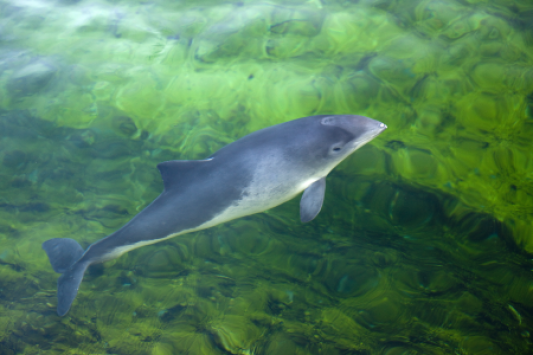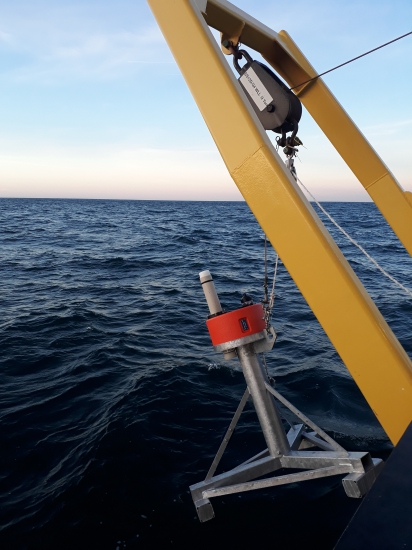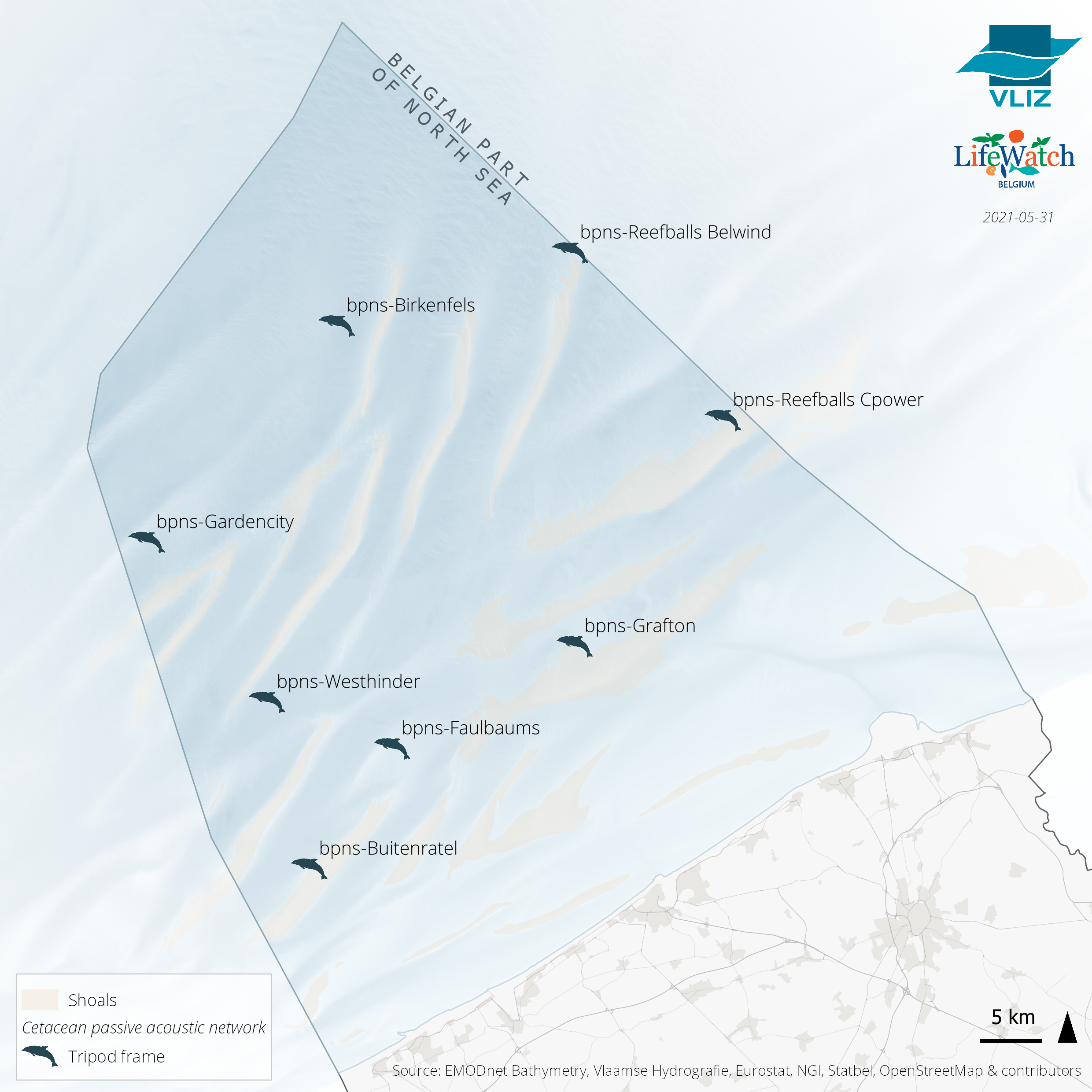You are here
Cetacean passive acoustic network
A passive acoustic hydrophone network has been put into operation to record the presence of porpoises and dolphins in the Belgian part of the North Sea (BPNS).
Scientific background
Porpoises and dolphins (Odontoceti) use echolocation to extract information from their surroundings. Dolphins produce clicks in a wide frequency range and are typically short and loud while porpoises are producing longer and weaker clicks in a narrow frequency range (120 - 145 kHz, mode 132 kHz). These clicks can be recorded by the passive acoustic device, C-POD (Chelonia Limited, figure below left), when a marine mammal is swimming in the vicinity of the recorder. The C-POD can record clicks between 20 and 160 kHz including ambient background noise, sonar and other biotic underwater sound. The key to the performance of the C-POD is detection and classification of series of clicks, so-called click trains. Click trains have distinctive features which are used by the classification algorithms to identify the occurring cetacean species.


Left: Example of a click train of harbour porpoise (Phocoena phocoena) - Right: Harbour porpoise (©Kustfotografie.be/Misjel Decleer)
Infrastructure
The development of a permanent network of C-PODs in the BPNS, as part of the marine LifeWatch observatory, started in 2014. Between 2014-2018, C-PODs were connected to navigation buoys or anchored to ship wrecks or to artificial hard structures. Since July 2018, all C-POD stations are equipped with a bottom moored tripod holding a C-POD and an acoustic release system (Vemco VR2AR), allowing for the full recovery of the equipment. The acoustic release system also acts as a receiver for acoustic tags, contributing to the LifeWatch fish acoustic receiver network. Stations outside the wind farm zone were relocated towards ship wrecks and are positioned along a an east-west gradient covering coastal, midshore and offshore zones of the BPNS. In 2021, eight C-PODs are continuously monitoring the presence of harbour porpoises and dolphins.


Left: C-POD attached to a tripod frame with an acoustic release system (©VLIZ); Right: Location of the 8 C-PODs in the Belgian Part of the North Sea (situation January 2021)
Data
Data can be accessed via the LifeWatch Data Explorer for marine mammals data.
Metadata is available at:
- LifeWatch observatory data: passive acoustic network (CPOD) for Cetacean detection, More
Useful links
- LifeWatch Data Explorer - C-POD data: Access and explore the gathered LifeWatch data
- CPOD Data Analysis Workshop: Learn from the findings of the 2017 LifeWatch Data Analysis workshop for the cetacean passive acoustic network.
- EPAN: Access, store and share passive acoustic data on the European Passive Acoustic Network data platform.
Most recent publications
- Calonge, A. (2022). Investigating spatiotemporal patterns in co-occurrence of the European seabass, the Atlantic cod and cetaceans by means of two types of acoustic technologies . MSc Thesis. Universiteit Antwerpen/Ghent University/Vrije Universiteit Brussel: Antwerpen, Gent, Brussel. 50 pp. [link to IMIS record]
- Rumes, B.; De Pauw, L.; Meys, J.; Debusschere, E.; Baetens, J.M. (2022). What drives harbour porpoise (Phocoena phocoena) response to pile driving sound?, in: Degraer, S. et al. Environmental impacts of offshore wind farms in the Belgian part of the North Sea: Getting ready for offshore wind farm expansion in the North Sea. Memoirs on the Marine Environment, : pp. 93-106 [link to IMIS record]
- Piesinger, N. (2019). Determining the impact of pile-driving activity on the spatio-temporal distribution of Harbour Porpoises (Phocoena phocoena) in the Belgian Part of the North Sea. MSc Thesis. Ghent University: Gent. 46 pp. [link to IMIS record]
- Augustijns, T. (2018). Harbour porpoises in the Belgian Part of the North Sea: Using passive acoustic monitoring to determine spatio-temporal patterns in distribution and feeding behaviour. MSc Thesis. Faculty of Sciences, Biology Department, Research Group Marine Biology: Gent. 47 pp. [link to IMIS record]
- Buyse, J. (2018). Monitoring of harbour porpoise (Phocoena phocoena) density in the Belgian part of the North Sea using aerial surveys and passive acoustic monitoring. MSc Thesis. Oceans & Lakes, Interuniversity Master in Marine and Lacustrine Science and Management: Antwerpen, Gent and Brussel. 13 [Literature review] + 32 [Manuscript] pp. [link to IMIS record]
- Degraer, S.; Brabant, R.; Braeckman, U.; Colson, L.; Courtens, W.; De Backer, A.; Debusschere, E.; Deneudt, K.; Haelters, J.; Hostens, K.; Kerckhof, F.; Moens, T.; Norro, A.; Reubens, J.; Ranson, J.; Rumes, B.; Stienen, E.; Vanermen, N.; Van de walle, M.; Verstraete, H. (2017). Executive summary: A continued move towards integration and quantification, in: Degraer, S. et al. Environmental impacts of offshore wind farms in the Belgian part of the North Sea: A continued move towards integration and quantification. pp. 7-11 [link to IMIS record]
- Rumes, B.; Debusschere, E.; Reubens, J.; Norro, A.; Haelters, J.; Deneudt, K.; Degraer, S. (2017). Determining the spatial and temporal extent of the influence of pile driving sound on harbour porpoises , in: Degraer, S. et al. Environmental impacts of offshore wind farms in the Belgian part of the North Sea: A continued move towards integration and quantification. pp. 129-141[link to IMIS record]
